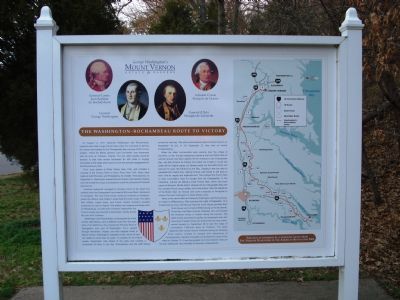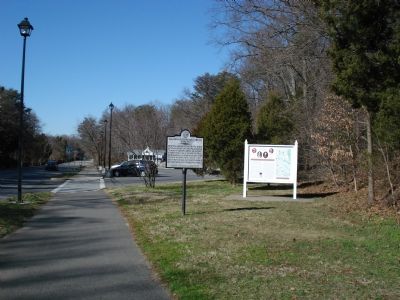Mount Vernon in Fairfax County, Virginia — The American South (Mid-Atlantic)
The Washington-Rochambeau Route to Victory
Their route started at White Plains, New York, and included a crossing of the Hudson River at Stony Point, New York. Stops were made at both Princeton and Philadelphia. At Chester, Pennsylvania, on September 5, Washington learned that de Grasse had reached Virginia and had landed the troops at Jamestown under the command of General Saint-Simon.
American watercraft managed to transport some of the allied foot soldiers down the Chesapeake from Head-of-Elk (now Elkton, Maryland) to Annapolis. The rest of the troops continued overland to Annapolis, where the infantry units halted to await boat lift further south. The allied field artillery, supply trains, and French cavalry (hussars) traveled southward by road to Virginia. The artillery and wagons eventually went to Williamsburg, 12 miles from Yorktown. Meanwhile, the French cavalry was diverted to Gloucester, directly across the river from Yorktown.
Washington and Rochambeau, accompanied by a few of their staff officers, took a different route from the main army. From Baltimore, they crossed the Potomac River at Georgetown (now part of Washington, D.C.), passed through Alexandria, Virginia, and then stopped briefly at Mount Vernon, Washington’s plantation home, which he had not visited for more than six years. To prepare for his French guests, Washington rode ahead of the party and covered a remarkable 60 miles in one day. Rochambeau and the staff officers arrived the next day. The allied commanders rested at Mount Vernon on September 10 and 11. On September 12, they rode on toward Fredericksburg.
When the allied commanders were passing near the village of Dumfries, a rider brought dispatches reporting that the British fleet of Admiral Graves had been sighted off the entrance to the Chesapeake Bay, and that Admiral de Grasse had sailed off to fight a crucial sea battle off the Virginia capes. De Grasse wisely cut the battle short and returned to cover the entrance to the Bay. Judging it was too risky to penetrate the French line, Admiral Graves was forced to sail back to New York for repairs and replenishment. This enabled the French fleet to deny Cornwallis’s hope for escape from the Chesapeake. In the meantime, Admiral De Barras’s small French
fleet, which had been based at Newport, Rhode Island, slipped into the Chesapeake Bay with the valuable French siege artillery and more troops. After the departure of the British fleet, de Grasse sent some transports to Annapolis to retrieve the main contingents of allied infantry units.
News of the naval battle led Generals Washington and Rochambeau to hasten to Williamsburg. After spending the night of September 12 in Fredericksburg, they rode through Hanover Court House and New Kent Court House, and arrived at Williamsburg on the fourteenth. There they met General Lafayette, who commanded the American forces in Virginia during the summer. The allied armies assembled supplies and equipment and, with the arrival of wagon trains and troops from the long march, moved forward on September 28 to start the siege of Cornwallis’s 7,500 man army at Yorktown. The allies tightened their control around Yorktown during the following three weeks. Unable to escape and despairing of reinforcements, General Cornwallis surrendered his army to the allies on October 19. It was the greatest and most decisive victory of the war, leading the way inevitably to American independence.
Erected 2004 by The Virginia Daughters of the American Revolution.
Topics and series. This historical marker is listed in this topic list: War, US Revolutionary . In addition, it is included in the Daughters of the American Revolution, the Former U.S. Presidents: #01 George Washington, and the The Washington-Rochambeau Route series lists. A significant historical month for this entry is September 1979.
Location. 38° 42.722′ N, 77° 5.304′ W. Marker is in Mount Vernon, Virginia, in Fairfax County. Marker is on Mount Vernon Memorial Highway, 0.1 miles west of Mount Vernon Highway (Virginia Route 235), on the right when traveling west. Touch for map. Marker is in this post office area: Alexandria VA 22309, United States of America. Touch for directions.
Other nearby markers. At least 10 other markers are within walking distance of this marker. Ona Judge (here, next to this marker); Washington-Rochambeau Route (here, next to this marker); Mount Vernon Estate (within shouting distance of this marker); Gateway to the Nation's Capital (about 400 feet away, measured in a direct line); Soil Improvements (about 400 feet away); George Washington's Mount Vernon (approx. 0.2 miles away); The Mount Vernon Memorial Highway (approx. 0.2 miles away); "The Texas Gate" (approx. 0.2 miles away); a different marker also named "The Texas Gate" (approx. 0.2 miles away); Origin of the Purple Heart Trail (approx. 0.2 miles away). Touch for a list and map of all markers in Mount Vernon.
Related markers. Click here for a list of markers that are related to this marker. 'Sister' displays in Virginia commemorating the route taken by Generals Washington and Rochambeau to Yorktown in September 1781.
Also see . . .
1. Washington-Rochambeau Route in Virginia. (Submitted on March 23, 2007, by Roger Dean Meyer of Yankton, South Dakota.)
2. Revision of the Washington-Rochambeau Route to Victory. (Submitted on April 30, 2009.)
Additional commentary.
1. Recent research may require partial revision of route description
Section of text describing the trace of the route taken by generals Washington and Rochambeau between Fredericksburg and Williamsburg may need to be corrected based upon the results of recent historical research. This is further explained on a separate webpage at the second link in the previous paragraph entitled “Revision of the Washington-Rochambeau Route to Victory.”
— Submitted April 30, 2009, by Albert D. McJoynt of Alexandria, Virginia.
Credits. This page was last revised on September 26, 2022. It was originally submitted on March 23, 2007, by Roger Dean Meyer of Yankton, South Dakota. This page has been viewed 2,236 times since then and 26 times this year. Photos: 1, 2. submitted on March 23, 2007, by Roger Dean Meyer of Yankton, South Dakota. • J. J. Prats was the editor who published this page.

